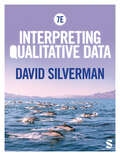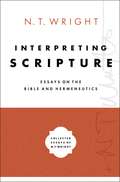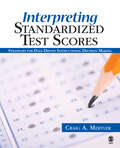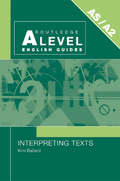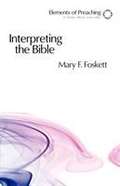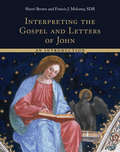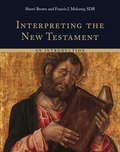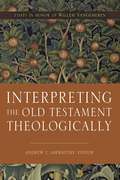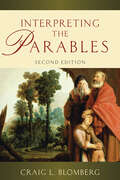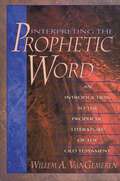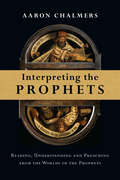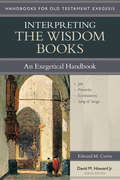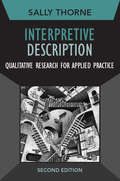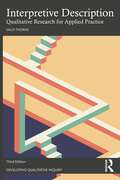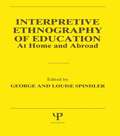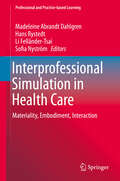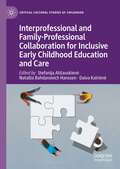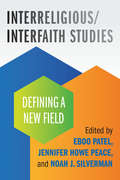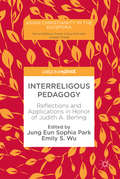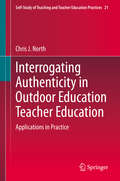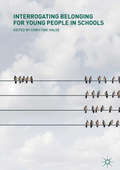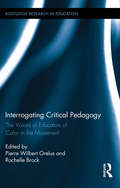- Table View
- List View
Interpreting Qualitative Data
by David SilvermanIn his signature pragmatic and friendly style, David Silverman acts as your stand-in supervisor in the seventh edition of this book, taking you step-by-step through different methods for making sense of qualitative data. Whether you are interested in analysing visual images, interviews, focus groups or online data, this book provides a clear framework for using qualitative data to answer your research questions. The book provides: • A strong grounding in research design principles so you can embed best practice into your research project. • Diverse real-world examples so you can see how principles are applied in practice. • Coverage of new developments in qualitative research including working with online data. If you are new to qualitative research or conducting your first research project in the social sciences, this book gives you the practical grounding in qualitative methods you need to get started.
Interpreting Qualitative Data
by David SilvermanIn his signature pragmatic and friendly style, David Silverman acts as your stand-in supervisor in the seventh edition of this book, taking you step-by-step through different methods for making sense of qualitative data. Whether you are interested in analysing visual images, interviews, focus groups or online data, this book provides a clear framework for using qualitative data to answer your research questions. The book provides: • A strong grounding in research design principles so you can embed best practice into your research project. • Diverse real-world examples so you can see how principles are applied in practice. • Coverage of new developments in qualitative research including working with online data. If you are new to qualitative research or conducting your first research project in the social sciences, this book gives you the practical grounding in qualitative methods you need to get started.
Interpreting Scripture: Essays on the Bible and Hermeneutics (Collected Essays of N. T. Wright #1)
by N. T. WrightDraws together the most important articles on Scripture and hermeneutics by distinguished scholar and author N. T. Wright. Interpreting Scripture brings together into one volume Wright's self-selected, key lectures, papers, and reflections on topics of scriptural interpretation, including:The Lord's Prayer as a Paradigm of Christian PrayerChristian Origins and the Question of GodFaith, Virtue, Justification, and the Journey to FreedomRevelation and Christian Hope: Political Implications of the Revelation to JohnApocalyptic and the Sudden Fulfilment of Divine Promise…and many more.Interpreting Scripture displays Wright's engaging prose, his courage to go where few have gone, and his joy to bridge the work of the academy and the church. Here is a rich feast for any serious student of the Bible, especially of the New Testament. Detailed, incisive, and exquisitely nuanced exegesis, this collection will reward you with a clearer, deeper, and more informed appreciation of Scripture and its application to Christian life and thought today.Many of the included studies have never been published or were made available only in hard-to-find larger volumes and journals.
Interpreting Standardized Test Scores: Strategies for Data-Driven Instructional Decision Making
by Craig A. Mertler"Craig A. Mertler′s approach would reduce your stress level as his book walks the reader through the various assessments often encountered in schools and helps the reader make better use of the information embedded in accountability reports. The book is well-organized and provides clear and thorough descriptions of the myriad terms the reader will encounter with assessments."—Lane B. Mills, THE SCHOOL ADMINISTRATOR"This text offers a clear, insightful study of how to interpret, use, and reflect on test data in ways that help to develop better schools, highly qualified teachers, and well prepared students."—Linda Karges-Bone, Charleston Southern UniversityAs standardized testing continues to grow in importance in our society, this text will become a critical part of measurement curriculum and instruction."—Gordon Brooks, Ohio UniversityInterpreting Standardized Test Scores: Strategies for Data-Driven Instructional Decision Making is designed to help K-12 teachers and administrators understand the nature of standardized tests and, in particular, the scores that result from them. This useful manual helps teachers develop the skills necessary to incorporate these test scores into various types of instructional decision making—a process known as "data-driven decision making"—necessitated by the needs of their students.Key FeaturesHelps readers understand, interpret, and use standardized test scores to improve classroom instruction: Several specific examples are given for interpreting test scores and developing a plan to revise instruction based on those results.Offers activities for application and reflection: Follow-up activities and discussion points are provided for experienced and preservice teachers across K-12 grade levels.Presents successful case studies: The author includes interviews with classroom teachers, building administrators, and district-level administrators who have successfully engaged in a process of incorporating test scores into decision making.Intended AudienceThis is an excellent supplementary text for any course that incorporates standardized testing as a topic, including but not limited to courses in Classroom Assessment, Educational Psychology, Content Methods, Reading, Special Education, Curriculum, Literacy, Administration, The Principalship, and The Superintendency.
Interpreting Texts (Routledge A Level English Guides)
by Kim BallardRoutledge A Level English Guides equip AS and A2 Level students with the skills they need to explore, evaluate and enjoy English. Books in the series are built around the various skills specified in the assessment objectives (AOs) for all AS and A2 Level English courses.Focusing on the AOs most relevant to their topic, the books help students to develop their knowledge and abilities through analysis of lively texts and contemporary data. Each book in the series covers a different area of language and literary study, and offers accessible explanations, examples, exercises, summaries, a glossary of key terms and suggested answers. Interpreting Texts:* breaks down the barriers which often inhibit the interpretation of texts* explores a wide variety of literary and non-literary examples* covers key skills and topics including discourse, intertextuality and theoretical approaches* guides the reader through the literary, social and cultural aspects of text* can be used as both a course stimulus and a revision tool.Written by an experienced teacher and AS and A2 Level examiner, Interpreting Texts is an essential resource for students of AS and A2 Level.
Interpreting The Bible: Approaching The Text In Preparation For Preaching (Elements Of Preaching)
by Mary Foskett O. AllenThis volume provides preaching students and clergy with introductory knowledge of current approaches and methods in biblical studies, familiarity with the questions and aims that pertain to them, and facility with various methods of biblical exegesis. Approaches to biblical interpretation are then examined in light of the questions and concerns that arise specifically in the context of preaching. Methods of biblical interpretation are reviewed and explained in succinct fashion and related directly to the dynamics that give rise to the sermon and shape exegesis for sermon preparation, namely, the preacher's engagement with the text, the author's context, and the congregation. This volume enables preachers to approach the biblical text with greater clarity.
Interpreting the Gospel and Letters of John: An Introduction
by Sherri Brown Francis J. MoloneyAccessible, comprehensive, and up-to-date, Interpreting the Gospel and Letters of John is an ideal text for students new to the discipline of biblical studies. Sherri Brown and Francis J. Moloney present a broad overview of the story of Christianity arising out of its Jewish foundations and proceed to guide readers expertly through the contents of the Gospel and Letters of John. Maintaining that Johannine literature is best understood against the background of the Old Testament covenant metaphor, Brown and Moloney focus on the central role of covenant in the narrative of John's Gospel and highlight the Evangelist's use of fulfillment language. Helpful sidebars, maps, questions for review, and further-reading lists are placed throughout the text, making this volume well suited for classroom use.
Interpreting the Gospel and Letters of John: An Introduction
by Sherri Brown Francis J. MoloneyAccessible, comprehensive, and up-to-date, Interpreting the Gospel and Letters of John is an ideal text for students new to the discipline of biblical studies. Sherri Brown and Francis J. Moloney present a broad overview of the story of Christianity arising out of its Jewish foundations and proceed to guide readers expertly through the contents of the Gospel and Letters of John. Maintaining that Johannine literature is best understood against the background of the Old Testament covenant metaphor, Brown and Moloney focus on the central role of covenant in the narrative of John's Gospel and highlight the Evangelist's use of fulfillment language. Helpful sidebars, maps, questions for review, and further-reading lists are placed throughout the text, making this volume well suited for classroom use.
Interpreting the New Testament
by Sherri Brown Francis J. MoloneyA succinct and accessible text for teaching students how to interpret the New TestamentThis new textbook effectively introduces students to the art and craft of biblical interpretation. New Testament scholars Sherri Brown and Francis Moloney begin by orienting students to the world of the Bible, exploring contemporary methods for interpreting the biblical literature, and showing how the Old Testament is foundational to the formation of the New Testament.The book proceeds to lead readers through the books of the New Testament by genre:* The Narratives: Gospels and Acts* Paul and His Letters* Hebrews and the Catholic Epistles* Apocalyptic Literature and the Book of Revelation Unlike book-by-book introductory textbooks that tend to overshadow the primary biblical text with lots of detailed information, Brown and Moloney&’s Interpreting the New Testament actually facilitates the study of the New Testament itself. Their concluding chapter reflects on the challenge of the New Testament to our present world.
Interpreting the New Testament: An Introduction
by Sherri Brown Francis J. MoloneyA succinct and accessible text for teaching students how to interpret the New TestamentThis new textbook effectively introduces students to the art and craft of biblical interpretation. New Testament scholars Sherri Brown and Francis Moloney begin by orienting students to the world of the Bible, exploring contemporary methods for interpreting the biblical literature, and showing how the Old Testament is foundational to the formation of the New Testament.The book proceeds to lead readers through the books of the New Testament by genre:* The Narratives: Gospels and Acts* Paul and His Letters* Hebrews and the Catholic Epistles* Apocalyptic Literature and the Book of Revelation Unlike book-by-book introductory textbooks that tend to overshadow the primary biblical text with lots of detailed information, Brown and Moloney&’s Interpreting the New Testament actually facilitates the study of the New Testament itself. Their concluding chapter reflects on the challenge of the New Testament to our present world.
Interpreting the Old Testament Theologically: Essays in Honor of Willem A. VanGemeren
by Andrew T. AbernethyHow should Christians read the Old Testament today? Answers to this question gravitate between two poles. On the one hand, some pay little attention to the gap between the Old Testament and today, reading the Old Testament like a devotional allegory that points the Christian directly to Jesus. On the other hand, there are folks who prioritize an Old Testament passage’s original context to such an extent that it is by no means clear if and how a given Old Testament text might bear witness to Christ and address the church.This volume is a tribute to Willem A. VanGemeren, an ecclesial scholar who operated amidst the tension between understanding texts in their original context and their theological witness to Christ and the church. The contributors in this volume share a conviction that Christians must read the Old Testament with a theological concern for how it bears witness to Christ and nourishes the church, while not undermining the basic principles of exegesis.Two questions drive these essays as they address the topic of reading the Old Testament theologically.Christology. If the Old Testament bears witness to Christ, how do we move from an Old Testament text, theme, or book to Christ?Ecclesiology. If the Old Testament is meant to nourish the church, how do scriptures originally given to Israel address the church today?The volume unfolds by first considering exegetical habits that are essential for interpreting the Old Testament theologically. Then several essays wrestle with how topics from select Old Testament books can be read theologically. Finally, it concludes by addressing several communal matters that arise when reading the Old Testament theologically.
Interpreting the Prophetic Word: An Introduction to the Prophetic Literature of the Old Testament
by Willem A. VangemerenThe diversity of prophetic voices in the Bible provides a message that is rich and variegated. But the variety of the testimony can be lost by limiting one's interpretations or application of the prophetic word. Interpreting the Prophetic Word helps readers understand the harmony of the voices that reveal God's purposes in redemptive history. Dr. Willem VanGemeren explains clearly and fully the background of the prophetic tradition. He then interprets the message of the major and minor prophets, using historical context and literary form and structure as tools in his analysis. He concludes with an explanation of the relevance of the prophetic word today. Dr. VanGemeren's extensive research and scholarship is presented in a readable way to unlock the door of prophecy for readers. He helps them to interpret prophecy and invites them to listen to the prophets and to lives the prophetic word.
Interpreting the Prophets: Reading, Understanding and Preaching from the Worlds of the Prophets
by Aaron ChalmersThe prophetic books are some of the most captivating and fascinating texts of the Old Testament, but they are also some of the most misunderstood. Interpreting the Prophets equips the reader with the knowledge and skills they need to interpret the Prophets in a faithful and accurate fashion. Beginning with the nature of the prophetic role and prophetic books in Israel, Old Testament scholar Aaron Chalmers leads the reader through the various "worlds" of Israel's prophets—historical, social, theological and rhetorical— providing the basic contextual and background information needed both for sound and sensible exegesis, and for sensitive interpretation and application for today. He concludes with a helpful chapter giving guidelines for preaching from the Prophets—including advice on choosing the texts, making appropriate analogies, and the potential problems and common pitfalls to avoid.
Interpreting the Wisdom Books: An Exegetical Handbook (Handbooks for Old Testament Exegesis)
by Edward M. CurtisThe Wisdom Literature of the Bible (Job, Proverbs, Ecclesiastes, and Song of Songs) is filled with practical principles for everyday life. While some Christians are deterred by the pragmatic character of these matter-of-fact guidelines, they are as integral to God's purposes for His people as the explicitly theological material that dominates other parts of Scripture. The Wisdom books tie these two streams of God's revelation together in a way that enriches and strengthens the church.It is a thorough resource for pastors and teachers to help them navigate the sometimes bewildering waters of the Wisdom Literature.
Interpretive Description: Qualitative Research for Applied Practice (Developing Qualitative Inquiry)
by Sally ThorneThe first edition of Interpretive Description established itself as the key resource for novice and intermediate level researchers in applied settings for conducting a qualitative research project with practical outcomes. In the second edition, leading qualitative researcher Sally Thorne retains the clear, straightforward guidance for researchers and students in health, social service, mental health, and related fields. This new edition includes additional material on knowledge synthesis and integration, evidence-based practice, and data analysis. In addition, this book takes the reader through the qualitative research process, from research design through fieldwork, analysis, interpretation, and application of the results; provides numerous examples from a variety of applied fields to show research in action; uses an accessible style and affordable price to be the ideal book for teaching qualitative research in clinical and applied disciplines.
Interpretive Description: Qualitative Research for Applied Practice (Developing Qualitative Inquiry)
by Sally ThorneInterpretive Description: Qualitative Research for Applied Practice has established itself as the key resource for novice and intermediate level researchers in applied settings for conducting a qualitative research project with practical outcomes.This book takes the reader through the qualitative research process, from research design through fieldwork, analysis, interpretation, and application of the results; provides numerous examples from a variety of applied fields to show research in action; and uses an accessible style to be the ideal book for teaching qualitative research in clinical and applied disciplines. In this new, third edition, leading qualitative researcher Sally Thorne retains the clear, straightforward guidance for researchers and students in health, social service, mental health, and related fields. This new edition includes additional material on positionality, disciplinary blindspots, design logic, arts-based approaches, diversity, mixed methods, writers' block, and dealing with critique. It has been comprehensively updated with new references and case examples throughout.Interpretive Description is an ideal resource for instructors and advanced students interested in qualitative research across a range of disciplines.
Interpretive Ethnography of Education at Home and Abroad
by George Louise SpindlerThis ambitious and unique volume sets a standard of excellence for research in educational ethnography. The interpretive studies brought together in this volume are outstanding discipline-based analyses of education both in the United States and in complex societies abroad.
Interprofessional Simulation in Health Care: Materiality, Embodiment, Interaction (Professional and Practice-based Learning #26)
by Madeleine Abrandt Dahlgren Hans Rystedt Li Felländer-Tsai Sofia NyströmThis book describes and discusses a practice-oriented approach to understanding and researching interprofessional simulation-based education and simulation. It provides empirical findings from research on this topic and is informed by practice-oriented perspectives. It identifies critical features of the simulation practice and discusses how these can be used in reforming simulation pedagogy. The book is divided into three sections. Section 1 sets the scene for understanding the practices of interprofessional simulation-based education and simulation. It provides a theoretical and methodological framework for the conceptualisation of practices and for the empirical studies on which the book is based. Section 2 revisits the dimensions of the simulation process/exercise, i.e. the briefing, simulation, and debriefing, and provides empirical analyses of how the practice of simulation unfolds. Based on these analyses, section 3 identifies and discusses how pedagogies for simulation can be reformed to meet the demands of future healthcare and research.
Interprofessional and Family-Professional Collaboration for Inclusive Early Childhood Education and Care (Critical Cultural Studies of Childhood)
by Natallia Bahdanovich Hanssen Stefanija Ališauskienė Daiva KairienėThis edited volume covers issues related to educational research and practices for early childhood education and care (ECEC), highlighting interprofessional and family-professional collaboration within inclusive education in different cultural contexts. Contributors include authors from throughout Europe, including Lithuania, Norway, Iceland, Finland, Sweden, Spain, UK, and Ukraine. Chapters provide a forum for intentional dialogue about and shared understanding of successful and inspiring ECEC practices, the main barriers of interprofessional and family-professional collaboration, and opportunities for further improvement of inclusive ECEC practices.
Interreligious/Interfaith Studies: Defining a New Field
by Eboo Patel Jennifer Howe Peace Noah SilvermanA groundbreaking academic anthology that explores the emerging field of interreligious/interfaith studiesAs it is now backed by an impressive number of courses, academic programs and centers, faculty positions, journals and publications, funding, and professional partnerships, there is no longer a question as to whether the interreligious/interfaith field exists. But its meaning and import are still being debated. How is this field distinct from, yet similar to, other fields, such as religious or theological studies? What are its signature pedagogies and methodologies? What are its motivations and key questions? In other words, what is the shape of interfaith and interreligious studies, and what is its distinct contribution? These questions are the driving force behind this anthology.
Interreligous Pedagogy: Reflections and Applications in Honor of Judith A. Berling (Asian Christianity in the Diaspora)
by Jung Eun Park Emily S. WuThis volume is a collection of essays by former students of Judith Berling based on her revolutionary interreligious pedagogy. Her pedagogy can be summarized as a student centered, collaborative, and engaging teaching and learning process sparked by various ways of boundary-crossing. In this enterprise, each chapter explores the importance of understanding and negotiating “differences” through dialogue. The authors provide theoretical frameworks for engagements across conventional borders, and explore how the collaborative teaching model can be utilized in various teaching settings. As an example of her dialogical approach, Judith Berling herself provides a response to the chapters.
Interrogating Authenticity in Outdoor Education Teacher Education: Applications in Practice (Self-Study of Teaching and Teacher Education Practices #21)
by Chris J. NorthThis book addresses student passivity in teacher education. Using a developed metaphor, the author critically examines the use of authentic learning to design and implement learning experiences for preservice teachers, and reveals the opportunities and limitations of a focus on authenticity.This book prepares teachers for outdoor education using practice-based exemplars of applied teaching theories. Focusing on authentic pedagogies, it applies to all teacher educators who seek to engage in high-impact learning for their students, and is relevant for in-service educators, preservice teachers and researchers in the field of self-study.
Interrogating Belonging for Young People in Schools
by Christine HalseIn an era when many young people feel marginalized and excluded, this is the first comprehensive, critical account to shed new light on the trouble of ‘belonging’ and how young people in schools understand, enact and experience ‘belonging’ (and non-belonging). It traverses diverse dimensions of identity, including gender and sexuality; race, class, nation and citizenship; and place and space. Each section includes a provocative discussion by an eminent and international youth scholar of youth, and is essential reading for anyone involved with young people and schools. This book is a crucial resource and reference for sociology of education courses at all levels as well as courses in student inclusion, equity and student well-being.
Interrogating Critical Pedagogy: The Voices of Educators of Color in the Movement (Routledge Research in Education)
by Pierre Wilbert Orelus Rochelle BrockEducators, teacher practitioners, and social activists have successfully used critical pedagogy as a tool to help marginalized students develop awareness and seek alternative solutions to their poor educational and socioeconomic situations. However, this theory is often criticized as being mostly dominated by privileged white males, bringing issues of race and gender to the forefront. This volume provides insight on how critical pedagogy can be helpful to scholars and teachers alike in their analysis of racial, gender, linguistic and political problems. It features a wide range of respected scholars who examine the way and the degree to which critical pedagogy can be used to improve education for students of color, women and other marginalized groups.
